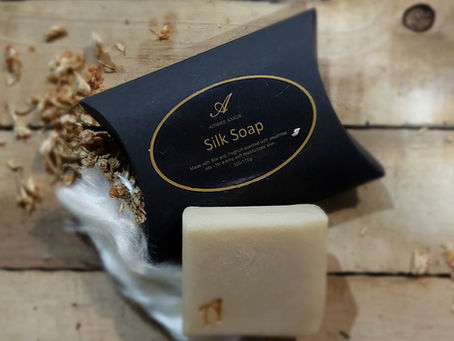Why does Glycerine soap sweat?
Admire Aarde
Glycerin soap sweats because of the ingredients included in the soap, which are glycerin and propylene glycol. Both glycerin and propylene glycol are humectants that draw moisture from the air. Once the glycerin soap has cooled down, place it in the desired packaging or an air-tight container.
The sweat can be wiped off with a clean cloth or paper towl.

Loofah soap on a rope
How to make a loofah soap?
You only need: Melt and pour soap base, Mica colours, Fragrance, a mould, loofah and rope.












EMULISIFIERS IN A BODY BUTTERS
Why do we use emulsifiers in body butter?
Emulsifiers in body butter serve several purposes:
Primary Functions:
1. Stabilize mixtures: Emulsifiers combine oil and water phases to create a consistent texture.
2. Improve moisture retention: Emulsifiers help lock in moisture, enhancing hydration and skin softness.
3. Enhance absorption: Emulsifiers facilitate the absorption of beneficial ingredients into the skin.
Benefits in Body Butters:
1. Smooth texture: Emulsifiers prevent separation and graininess.
2. Better spreadability: Emulsifiers improve glide and application.
3. Increased shelf life: Emulsifiers reduce spoilage and rancidity.
4. Improved skin feel: Emulsifiers can leave skin feeling softer, smoother, and more hydrated.
Common Emulsifiers in Body Butters:
1. Natural emulsifiers:
- Beeswax
- Candelilla wax
- Carnauba wax
- Vegetable emulsifiers (e.g., glyceryl oleate)
2. Synthetic emulsifiers:
- Polysorbates (e.g., polysorbate 60)
- Sodium stearoyl lactylate
- Cetearyl alcohol
Factors to Consider:
1. Skin type: Choose emulsifiers suitable for sensitive or dry skin.
2. Ingredient compatibility: Ensure emulsifiers work well with other ingredients.
3. Concentration: Balance emulsifier levels to avoid greasiness or separation.
4. pH level: Emulsifiers can affect pH; adjust accordingly.
PRESERVATIVES
WHEN AND WHY TO USE PRESERVATIVES?
Preservatives are essential in cosmetic products to prevent microbial growth, contamination, and spoilage. Here's when to use preservatives:
*Why Use Preservatives?*
1. Prevent bacterial, fungal, and yeast growth.
2. Protect products from contamination.
3. Extend shelf life.
4. Ensure safety and efficacy.
*When to Use Preservatives?*
1. Water-based products (e.g., creams, lotions, serums).
2. Products with high water activity (Aw > 0.6).
3. Products with pH between 4.5 and 9.5.
4. Products containing nutrients (e.g., proteins, vitamins).
5. Products exposed to air, water, or human contact.
6. Products stored in humid or warm environments.
*Product Types Requiring Preservatives:*
1. Skincare (creams, lotions, serums, masks).
2. Haircare (shampoos, conditioners, masks).
3. Makeup (foundations, concealers, eyeshadows).
4. Bath products (soaps, body washes, bubble baths).
5. Oral care (toothpastes, mouthwashes).
*Factors Influencing Preservative Choice:*
1. Product type and pH.
2. Water activity and humidity.
3. Storage conditions.
4. Ingredient interactions.
5. Regulatory
*Best Practices:*
1. Conduct preservative efficacy testing.
2. Follow GMP (Good Manufacturing Practice) guidelines.
3. Monitor product stability and shelf life.
4. Label products with preservative
W/O OR O/W EMULSIONS
WHEN TO USE W/O OR O/W EMULSIONS?
W/O (Water-in-Oil) and O/W (Oil-in-Water) emulsions are two fundamental types of emulsions used in cosmetics, pharmaceuticals, and food industries.
*W/O (Water-in-Oil) Emulsion:*
1. Water droplets dispersed in an oil phase.
2. Oil-soluble emulsifiers (e.g., mineral oil, petroleum jelly).
3. Typically thick and rich, with a creamy texture.
4. Better moisturizing and occlusive properties.
5. Often used in:
- Moisturizers
- Creams
- Ointments
- Sunscreen
*O/W (Oil-in-Water) Emulsion:*
1. Oil droplets dispersed in a water phase.
2. Water-soluble emulsifiers (e.g., polysorbates, sodium lauryl sulfate).
3. Typically lighter and more fluid, with a lotion-like texture.
4. Better penetration and spreadability.
5. Often used in:
- Lotions
- Serums
- Facial creams
- Shampoos
*Key differences:*
1. *Texture*: W/O emulsions are thicker and richer, while O/W emulsions are lighter and more fluid.
2. *Stability*: W/O emulsions are generally more stable, while O/W emulsions require more surfactants to maintain stability.
3. *Moisturizing properties*: W/O emulsions provide better moisturization, while O/W emulsions offer better penetration.
4. *Application*: W/O emulsions suit dry skin, while O/W emulsions suit oily skin.
*Choosing between W/O and O/W emulsions:*
Consider:
1. Skin type (dry, oily, combination).
2. Desired texture and feel.
3. Product purpose (moisturizing, cleansing, protecting).
4. Ingredient compatibility.






























